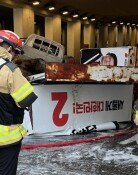Report: What Organizations Have Received the Most Bribes and Treats from Those Who Made Civil Petitions
Report: What Organizations Have Received the Most Bribes and Treats from Those Who Made Civil Petitions
Posted June. 03, 2005 06:50,
It was made public that officials of the Ministry of Planning and Budget (MOPB) have received the most bribes and treats from those who made public petitions out of the total of 32 central government ministries (including Cheong Wa Dae and the Presidential Committees).
A report that the Korea Independent Commission Against Corruption (KICAC) (Chairman: Chung Soung-jin) submitted to Grand National Party Rep. Kim Jae-kyung and the Legislation & Judiciary Committee of the National Assembly on June 2 showed that more than five persons (five percent) out of 100 who came to the MOPB to make civil petitions provided its officials with bribes and treats. The MOPB is followed by the Korea Railroad, the Ministry of Maritime Affairs and Fisheries, the Ministry of Agriculture and Forestry, and the Korea Food and Drug Administration.
This report is the result of a survey that a specialized public opinion research institute conducted at the request of the KICAC by interviewing a total of 75,317 people who have gone to a total of 313 public organizations, including the central government ministries, public corporations, local governments, and provincial offices of education, from September 2003 to July 2004 in order to gauge the integrity of public officials.
Although the KICAC has revealed general integrity, including an effort to prevent corruption, and fairness in dealing with their tasks, this is first time that it disclosed specific rankings by calculating how much public officials have received bribes and treats.
Among the total of 313 public organizations, the proportion of bribes and treats received from those who made civil petitions was an average of 1.5 percent (3,022 cases), to the sum of 696.04 million won. It was discovered that, among those who made civil petitions with providing officials with bribes and treats, each person spent an average of 610,000 won for an average of 2.65 cases.
The Korea Rails Network Authority topped the list at a little over five percent out of 15 public corporations (including public offices-related organizations), followed by the Korea Gas Safety Corporation, the Korea Electrical Safety Corporation, the National Agricultural Cooperative Federation, and the Korea Agricultural & Rural Infrastructure Corporation.
In addition, Gwangju, Gyeonggi Province, Ulsan, Busan, and Chungbuk Province out of the upper-level local governments (including the Seoul Metropolitan Government, other metropolitan cities and provincial government bodies), and Ulleung-gun, Gyeongbuk Province, Gijang-gun, Busan, Seongnam-si, Gyeonggi Province, Gimhae-si, Gyeongnam Province, and Jeju-si, Jeju Province out of the lower-level local governments (including each city, gun, and gu) ranked in order regarding the proportion of bribes and treats received. (si and gun are equivalent to a city and county respectively)
The Gwangju Office of Education topped the list among the 16 provincial offices of education, followed by the Jeonnam Office of Education, the Ulsan Office of Education, the Daegu Office of Education, and the Busan Office of Education.
It was revealed that concerning the proportion of bribes and treats received, the following organizations showed the lowest levels: the Military Manpower Administration out of the governmental ministries, the Korea Deposit Insurance Corporation out of public corporations, Jeju Province out of the upper-level local governments, and Chungnam Office of Education out of the provincial offices of education.
Myoung-GunLee Jung-Eun Lee gun43@donga.com lightee@donga.com







